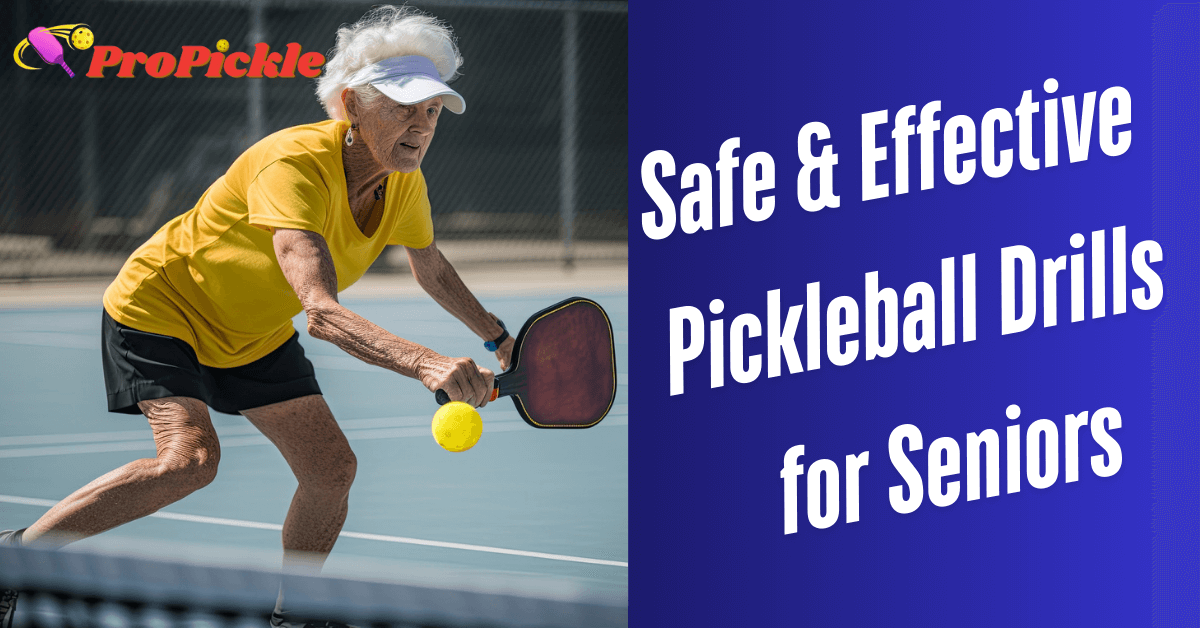Pickleball isn’t just for the young! Seniors can stay active and sharpen their skills with drills tailored to their needs. Whether you’re recovering from an injury or just want to practice safely, these home-friendly pickleball drills focus on balance, control, and low-impact movements.
For seniors, home drills offer:
- Safety: Avoid crowded courts and uneven surfaces.
- Convenience: Practice at your own pace, anytime.
- Focus on Fundamentals: Build muscle memory for dinks, volleys, and footwork.
A 2023 study by the National Institute on Aging found that seniors who engage in regular balance exercises reduce their fall risk by 34%.
Why Seniors Should Prioritize Balance and Control
As we age, reaction time and stability naturally decline. These drills help:
- Strengthen core muscles to prevent falls.
- Improve hand-eye coordination for precise shots.
- Build confidence in a risk-free environment.
Essential Gear for Home Drills
- Foam Pickleballs: Quieter and safer for indoor use (Onix Pure 2 Outdoor Ball).
- Non-Slip Mat: Prevent slips during footwork drills.
- Lightweight Paddle: 7.0–7.5 oz for reduced joint strain.
Drill #1: Wall Rally Practice
Goal: Improve hand-eye coordination and soft shots.
How To:
- Stand 6 feet from a blank wall.
- Hit the ball against the wall using gentle dinks or volleys.
- Aim for 20 consecutive hits without dropping the ball.
Pro Tip: Use a foam pickleball to reduce bounce and strain on joints.
Drill #2: Chair-Based Dinking
Goal: Master soft shots while seated (ideal for limited mobility).
How To:
- Sit in a sturdy chair with your paddle and ball.
- Toss the ball slightly upward and practice dinking it into a laundry basket 5 feet away.
- Focus on wrist flexibility, not power.
Drill #3: Slow-Motion Footwork
Goal: Enhance balance and court movement mimicry.
Steps:
- Lay down tape to mark a “kitchen line” and “baseline” on your floor.
- Practice moving side-to-side and forward/backward in slow motion.
- Hold your paddle in ready position while shifting weight.
Pro Tip: Add light ankle weights (1–2 lbs) for resistance.
Drill #4: Shadow Swinging
Goal: Refine swing mechanics without a ball.
Steps:
- Stand in front of a mirror.
- Practice forehand and backhand swings, focusing on proper form.
- Rotate hips and shoulders with each swing.
Pro Tip: Record yourself to analyze technique.
Drill #5: Target Practice
Goal: Boost accuracy for serves and drops.
Steps:
- Place hula hoops or towels as targets 10–20 feet away.
- Aim to land the ball inside the target zones.
- Alternate between forehand and backhand shots.
Pro Tip: Start with larger targets and shrink them as you improve.
Drill #6: Balloon Volleys
Goal: Improve reaction time and soft touches.
Steps:
- Inflate a balloon and hit it with your paddle.
- Keep the balloon airborne using controlled taps.
- Alternate hands or challenge yourself to 50 consecutive hits.
Pro Tip: Use two balloons for advanced coordination.
Drill #7: Mirror Partner Drill
Goal: Simulate real-game rallies solo.
Steps:
- Stand 10 feet from a wall or fence.
- Hit the ball against the surface and mimic returning your own “opponent’s” shot.
- Focus on footwork and paddle positioning.
Pro Tip: Pretend you’re playing doubles for added engagement.
Safety Tips for Senior Players
- Use non-slip mats to prevent falls during footwork drills.
- Take 1–2 minute breaks between sets to avoid overexertion.
- Invest in a lighter paddle (7.0–7.5 oz) to reduce shoulder strain.
- Warm Up: 5 minutes of arm circles and ankle rolls.
- Hydrate: Keep water nearby to avoid dehydration.
- Use Proper Lighting: Ensure your practice area is well-lit.
FAQs
1. Can I practice without a paddle?
Yes! Use your hand to volley the ball for reaction training.
2. How long should each drill session last?
Start with 15–20 minutes daily, gradually increasing to 45 minutes.
3. Are these drills safe for arthritis sufferers?
Absolutely—use a paddle with a cushioned grip like the ProLite Comfort Series.
4. Can I do these drills alone?
Yes, all drills are designed for solo practice.
5. What if I don’t have a foam ball?
Use a whiffle ball or crumpled paper ball as a substitute.
Bonus: Download our free Printable Drill Checklist to track your progress!


Leave a Reply